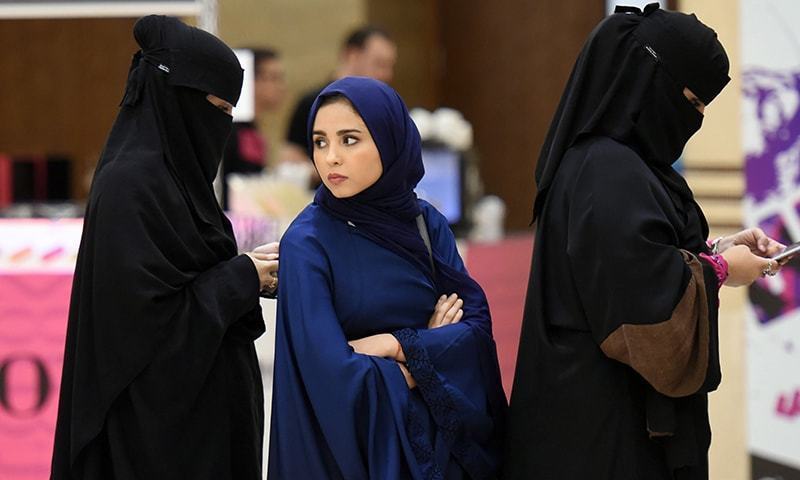Pakistan may be the fourth largest cotton producer worldwide, but its value-added sector has a small share in its total exports. One of its reasons is the country’s dependence on conventional value-added products.
The Muslim apparel industry, which is currently dominated by Malaysia, Turkey and Indonesia, has a huge potential for Pakistan’s garment sector.
According to a BBC story, the global hijab market was worth $230 billion in 2014. It predicted the market size would be $327bn by 2020. Pakistan’s textile industry needs to come up with higher value-added products such as hijab and abaya for the international market. Demand for Islamic clothing has led to growth in the international Muslim fashion industry.
In a relatively short time, Muslimwear has become an important segment of the international textile industry. Japanese fashion giant Uniqlo’s recently launched hijab in the United Kingdom after successful runs in the United States, Malaysia, Singapore, Indonesia and Thailand.
There is still a fairly big space for newcomers as some non-Muslims have also started covering their heads now. According to one report, hijab became popular in the United States when Harbhajan Singh Khalsa, a yogi and spiritual teacher, asked his followers to cover their heads with a scarf or hijab. The reason he gave was that the skull is made up of tiny bones that are constantly moving even if by only micro-millimetres. The degree to which they move impacts the level of calmness or anxiety.
Therefore, covering the head stabilises the cerebral matter and the 26 parts of the brain, which are interlocked with the neurological system and electromagnetic field. It creates a focus of the functional circuit of the hemispheres of the brain and tunes the neurological system.
The popularity of his theory has given an unexpected boost to the hijab industry. Multicoloured, ready-to-wear and stylish hijabs are sold for not less than $25 in the wholesale market. Pakistani hijab suppliers are offering $2 to $4 per piece. But they are not organised enough to compete with Malaysia, Turkey or Indonesia. Time is ripe for Pakistani exporters to enter into a joint venture with international brands selling hijab.
Turkey is the world’s largest consumer of Muslim clothing. Turks spent $39.3bn on merchandise in 2013, according to Reuters. The United Arab Emirates was second with $22.5bn. Spending on high-end Sharia-compliant clothing by Muslims is surging. They are expected to spend about $484bn by 2019, Reuters estimates.
Those numbers will only climb as Muslims become more aware of the fashion already ubiquitous in the Middle East. Designers around the world started taking notice of this trend in the early 2000s. The Islamic Fashion Festival started taking place in 2006 in Kuala Lumpur. Seventeen such festivals have taken place in fashion hubs like New York, London, Jakarta, Dubai, Singapore, Monte Carlo and other cities since then.
Dubai has set up a special design district offering tax breaks to companies and designers willing to relocate to the city-state, according to Bloomberg, as the emirate wants to become the world’s Muslim fashion capital. DKNY saw an opportunity last summer and released a Ramazan collection that sold in the Arabian Gulf only. The GDP of countries with a majority Muslim population is projected to grow at an average of 5.4pc a year as opposed to 3.4pc of Europe and the United States over the next few years.
Local entrepreneurs are not the only ones to have jumped on the Muslim fashion bandwagon. Large brands, such as DKNY and H&M, have also joined in
Local entrepreneurs and designers are not the only ones to have jumped on the Muslim fashion bandwagon. Large international brands such as DKNY, H&M and Uniqlo have also created collections to cater to the Muslim market.
More recently, D&G unveiled its abaya and hijab collection, causing a stir in the luxury fashion world and setting a precedent for other design houses. Italian entrepreneur Paolo Costanzo, the founder of the Infinita Group and the regional representative of the Islamic Fashion and Design Council, is about to launch a luxury fashion website catering to high-end Muslim consumers.
Nike, the well-known US sportswear company, recently introduced a sports hijab. The use of an official sports hijab in competition dates back to July 2012 when the International Football Association Board (IFAB), custodians of the rules of soccer, overturned a 2007 ban that had argued that the hijab was ‘unsafe’ for sportspersons as it could increase the risk of neck injuries.
While overturning the ban, the IFAB noted that there was nothing in “the medical literature concerning injuries as a result of wearing a headscarf”. The sports hijab is secured in place with magnets. If it gets pulled off, another cap remains underneath to cover the sportsperson’s hair without causing any injuries. In 2012, Muslim athletes wearing the hijab received considerable media attention.
Wearing the hijab set them apart from other Olympic athletes. Since then, several sports hijab companies — much before Nike’s pro hijab — have joined this business. International retailers such as Marks and Spencer and Uniqlo have launched ranges aimed at Muslim women. With high-end embellished hijab and abaya collections, H&M, Dolce and Gabbana, Zara and Uniqlo caused a stir in the luxury fashion world when they launched clothing lines targeting the Muslim shopper. It is time Pakistani exporters availed this opportunity.
Published in Dawn, The Business and Finance Weekly, December 24th, 2018

















































